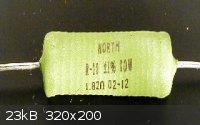tubelectric
Harmless

Posts: 18
Registered: 13-11-2012
Member Is Offline
Mood: Hypergolic
|
|
Ceramic resistor material?
I have a few resistors, less than 10 ohms, rated at a few watts, salvaged from old TVs which were at least 25 years old I think. They have rectangular
package made of some brown ceramic (?) material. Today I noticed that one of them had white powder and flakes on its surface, and some of it had
peeled off.
Can anyone identify this material? Most importantly, does it contain toxic components? I know that beryllium oxide is sometimes used in resistors but
I think there were no warning labels and I also don't see any reason for using expensive and dangerous BeO in low-end applications like this.
|
|
|
12AX7
Post Harlot
    
Posts: 4803
Registered: 8-3-2005
Location: oscillating
Member Is Offline
Mood: informative
|
|
Probably some combination of alumina, silica and lime oxides and cement. I don't know what exactly they use, but it's not going to be BeO -- too
specialized. Possibly you can find an MSDS talking about what materials are used. "Sand" resistors are still used today, and likely use the same
materials.
Thick film resistors might be BeO, but only for special purposes; I think the average thick film substrate is >97% Al2O3 ceramic.
Tim
|
|
|
bfesser
Resident Wikipedian
    
Posts: 2114
Registered: 29-1-2008
Member Is Offline
Mood: No Mood
|
|
<img src="../scipics/user:bfesser/lime_oxide.jpg" />
|
|
|
IrC
International Hazard
    
Posts: 2710
Registered: 7-3-2005
Location: Eureka
Member Is Offline
Mood: Discovering
|
|
Simple sand resistors, wirewound with NiCr wire. Nothing special and nothing toxic. A ceramic tube of small diameter wound with the wire and placed in
a ceramic shell. This is then filled with a cement made of sand and Tim's fruity binders.
Beat one with a hammer it will be obvious how it is made.
"Science is the belief in the ignorance of the experts" Richard Feynman
|
|
|
tubelectric
Harmless

Posts: 18
Registered: 13-11-2012
Member Is Offline
Mood: Hypergolic
|
|
Yeah, I'm going to break one of those and see what happens. Thanks for your answers.
Finding an MSDS might be too hard, those TVs were very old and the resistor markings have worn out.
|
|
|
IrC
International Hazard
    
Posts: 2710
Registered: 7-3-2005
Location: Eureka
Member Is Offline
Mood: Discovering
|
|
In the age of dinosaurs when they made those TV sets no thought was ever given to writing an MSDS for sand resistors. Why would they? If you plan on
eating the wire inside you might look up nichrome. Not really sure why you would need one for the only other component (sans leads), i.e., sand or
SiO2. Possibly also Al2O3 might enter the equation but really, why would you need an MSDS for anything in the resistor?
"Science is the belief in the ignorance of the experts" Richard Feynman
|
|
|
ScienceSquirrel
International Hazard
    
Posts: 1863
Registered: 18-6-2008
Location: Brittany
Member Is Offline
Mood: Dogs are pets but cats are little furry humans with four feet and self determination! 
|
|
In those days you did not need an MSDS for a fishing weight.
Now we are getting close to it.
|
|
|
12AX7
Post Harlot
    
Posts: 4803
Registered: 8-3-2005
Location: oscillating
Member Is Offline
Mood: informative
|
|

Redundant I suppose, unless you'd consider calcium per/superoxide "lime oxide".
|
|
|
tubelectric
Harmless

Posts: 18
Registered: 13-11-2012
Member Is Offline
Mood: Hypergolic
|
|
Hammered one into pieces - brown clay-like fragments from the package, and sand inside. So nothing special I think. The white flakes on the surface
were just weird.
|
|
|
tubelectric
Harmless

Posts: 18
Registered: 13-11-2012
Member Is Offline
Mood: Hypergolic
|
|
Funny stuff those flakes - I cleaned the box where I stored those resistors and I think they dissolved in water. Then I crushed another resistor,
dropped it into strong acetic acid (50%-vol maybe) and it apparently released some gas.
|
|
|
12AX7
Post Harlot
    
Posts: 4803
Registered: 8-3-2005
Location: oscillating
Member Is Offline
Mood: informative
|
|
Perhaps efflorescence from a calcium based cement?
|
|
|
ElectroWin
Hazard to Others
  
Posts: 224
Registered: 5-3-2011
Member Is Offline
Mood: No Mood
|
|
i seem to recall that some ceramics having perovskite structure will conduct electricity.
maybe this will help?
http://www.mpi.stonybrook.edu/energy/IonicConductivity/ionic...
on second thought, i dont know if it will.
[Edited on 2013-7-15 by ElectroWin]
|
|
|
IrC
International Hazard
    
Posts: 2710
Registered: 7-3-2005
Location: Eureka
Member Is Offline
Mood: Discovering
|
|
The reason for the ceramic frame and sand filler is to contain the nichrome wound form. Therefore you will find the wire in a wirewound (sand)
resistor. Are you sure you are not looking at glass carbon resistors? In these you will find metal film or carbon film wound in a spiral, not wire.
http://electrical-info.com/resistors/
Below is a pic of a sand cast resistor, wirewound on ceramic form then a coating of fine sand/cement is baked on. Higher values can be metal oxide
types instead of wire.

http://engg-techbasics.blogspot.com/2011/01/resistor-and-its...
This link shows a pic of what I think you have.

[Edited on 7-16-2013 by IrC]
"Science is the belief in the ignorance of the experts" Richard Feynman
|
|
|
tubelectric
Harmless

Posts: 18
Registered: 13-11-2012
Member Is Offline
Mood: Hypergolic
|
|
Probably. Actually it looked exactly like that. Thanks to everyone for answers.
These resistors had a wire inside. There are resistors where the entire body conducts electricity but I think carbon is the main conductive component
in them.
|
|
|
ElectroWin
Hazard to Others
  
Posts: 224
Registered: 5-3-2011
Member Is Offline
Mood: No Mood
|
|
in that case, the wire is the resistive element
|
|
|